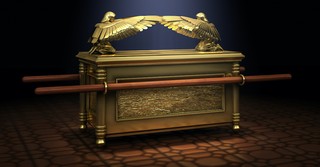What Is the Significance of the Tabernacle Furnishings?
Share

In Hebrews 9:1-9, the author of Hebrews listed the furnishings of the tabernacle built at Mt. Sinai. He concluded with the comment that he did not have the time to discuss each of those elements, launching instead into a description of the sacrifice offered on the day of atonement and Jesus’ fulfillment of that sacrifice.
Nowhere in the Scripture do we find an explicit discussion of the significance of these furnishings. But we are given clues. This article intends to look at some of those clues and attempt to understand some of the greater significance of the tabernacle and its furnishings.
A Copy of the Heavenly
In Exodus 25-27, the Tabernacle and its furnishings were first described. It was to be a holy place for God to dwell among his people. Moses was instructed to make this tabernacle, and its furnishings, exactly like the pattern he was shown (Ex. 25:9).
Hebrews 8:5 and Hebrews 9:24 both express that this tabernacle Moses was instructed to build was a copy of the true one in heaven. And Hebrews 9:11-12 says that Jesus went through the greater and more perfect tabernacle – one that was not made by human hands and not a part of this creation. And he entered the Most Holy Place of this heavenly tabernacle to offer his blood as an atoning sacrifice.
The two tabernacles' construction, materials, and appearances are less important here than what they represent. The earthy tabernacle itself, and each of its furnishings, represent something that is found in the heavenly tabernacle.
The Ark of the Covenant Law
The ark was a gold-clad chest, and in it were the two stone tablets of the covenant law (Ex. 26:16). These tablets had the 10 Commandments, representing the law, inscribed on them. This ark, and the cover over it, were the most sacred objects of Israel’s religious life.
In Jeremiah 31:31-34, God spoke of a time when he would establish a new covenant with his people. It would not be like the covenant he established at Sinai. Rather than being written on stone tablets, the laws of the new covenant would be written on our hearts.
Under the old covenant, the law was written on stone and kept in a box. In contrast, under the new covenant, the law is written on our hearts and kept within us. My life now is what the Ark of the Covenant law once was. It is where God’s law is hidden and preserved.
The Atonement Cover
Over the ark, and closely associated with it, is the Atonement Cover. It was made of pure gold with a pair of cherubim on top; wings spread to overshadow the cover. The Atonement Cover was also called the Mercy Seat in some translations. It represented the dwelling of God within the tabernacle as well as the place of atonement.
In 1 Chronicles 6, we find the story of David bringing the ark into Jerusalem. And in 1 Chronicles 6:2, God is said to be enthroned between the cherubim over the ark. 2 Kings 19:15 and Isaiah 37:16 repeat this idea of God being enthroned between the cherubim.
In Exodus 25:22, God told Moses that he would meet with him above the cover and between the two cherubim. From there, he would give Moses the commands that he was to pass on to Israel. And in Number 7:89, we are told that when Moses entered the tent to speak with God, he heard a voice speaking to him from between the two cherubim over the cover.
The Atonement Cover also played a significant role in Israel’s sacrificial system. On the Day of Atonement (Lev. 16), the high priest offered sacrifices for his own atonement as well as for the atonement of the community. Some of the blood of these two sacrifices, along with coals and incense from the altar of incense, was taken behind the curtain, into the Most Holy Place, and sprinkled on the front of the atonement cover. In doing that, the high priest made atonement for himself and for the people (Lev. 16:17).
The atonement cover is the place where atonement was made for the people. And, in that regard, it is looking forward to the cross, where Jesus, our great high priest, offered the perfect sacrifice of himself (Heb. 9:11-14).
The atonement cover is also the throne of God. And it is where I go to meet with God, to talk with him and hear his voice giving me direction.
The Table
On the north side of the outer room of the tabernacle, there was a small gold-covered table (Ex. 25:23-30, 40:22). Associated with this table was a variety of plates, dishes, pitchers, and bowls, each constructed of gold, and whose purpose was undefined. On this table was also the bread of the Presence (Ex. 25:30).
Each Sabbath, twelve new loaves were to be set out on this table (Lev. 24:5-9). This bread was a food offering to the Lord and was to be eaten by the priests in the sanctuary. There is a sense in which the priests were invited to share a meal with God as they ate the bread.
In John 6:48, Jesus said that he was the bread of life. Then, in John 6:51, he said, “I am the living bread that came down from heaven. Whoever eats this bread will live forever.” Jesus shared a last meal with his disciples on the night he was betrayed. And as he broke the bread, he told them to “Take and eat; this is my body.”
The bread of the Presence would seem to look forward to Jesus, the bread of life. And, as the priests were invited to enter the sanctuary and eat the bread, we are invited to eat the bread of life and enter the heavenly sanctuary.
The Lampstand
A second piece of furnishing within the tabernacle was a lampstand (Ex. 25:37). This lampstand was made of pure gold and had seven lamps. The lampstand was placed on the opposite side of the outer room of the tabernacle from the table (Ex. 40:24). These lamps were to be refilled twice daily (Ex. 30:7-8) and kept burning continuously (Ex. 20:21).
Lampstands are mentioned a few other times in the Scripture. In Zechariah 4, the prophet saw a lampstand resembling what is described above, along with two olive trees (Zech. 4:2-3). And, in Zechariah 4:10, the seven eyes of God that range throughout the earth are mentioned, seeming to refer to the lampstand.
What appears to be the same lampstand is also found in Revelation 4:5. This lampstand is located in front of the throne of God and is described as the seven Spirits of God. The lampstands in both Zechariah and Revelation would seem to be the Holy Spirit.
This makes it easy to visualize the lampstand in the tabernacle as symbolizing the Holy Spirit, giving light to the tabernacle, the people of God.
The Altar of Incense
The final piece of furniture in the outer room of the tabernacle was the Altar of Incense. This altar was a small wooden table overlaid with gold that sat before the curtain that shielded the Most Holy Place (Ex. 30:1-6). This altar was used for burning a unique blend of incense, once in the morning and once in the evening (Ex. 30:7-9).
When a sin offering was made, some of the blood from the animal was put onto the horns of the Altar of Incense (Lev. 4:7). This included the sin offering made on the Day of Atonement (Lev 16:18-19). Also, on the Day of Atonement, some coals from the Altar of Incense and fresh incense were taken into the Most Holy Place to shield the Atonement Cover from view (Lev. 16:12-13).
In Revelation 8:3-4, the altar of incense is pictured. But in this case, it is an angel rather than the high priest who brought the incense into the Most Holy Place, before the throne of God, represented in the earthly sanctuary as the Atonement Cover. And mixed with the incense were the prayers of the saints, rising up before God.
The incense offered in the tabernacle represents our prayers being offered to God. Our prayers, offered at the altar, are a pleasing aroma to God. He delights to hear from us.
Summary
When Moses had the tabernacle built at Mt. Sinai, it was according to a very specific pattern given to him by God. And the author of Hebrews points out that this tabernacle was a copy of a heavenly and more perfect tabernacle. This does not mean that the heaven tabernacle has the same physical appearance as the Sinai tabernacle, but everything in the earthly tabernacle pointed to something much more significant.
The author of Hebrews tells us that the sacrifices, especially the sacrifice of atonement, pointed to what Jesus did on the cross. He became the High Priest taking the blood of the sin offering into the Most Holy Place. But, while he alluded to their significance, he declined to discuss the significance of the tabernacle’s furnishings.
The symbolism assigned to the furnishings in this article may not be entirely correct. And there might be other things they represent or point to. But hopefully, this article will encourage you to consider the tabernacle – and its furnishings – as representing something much more significant than just a portable sanctuary for Israel.
Photo credit: ©Getty Images/jgroup
